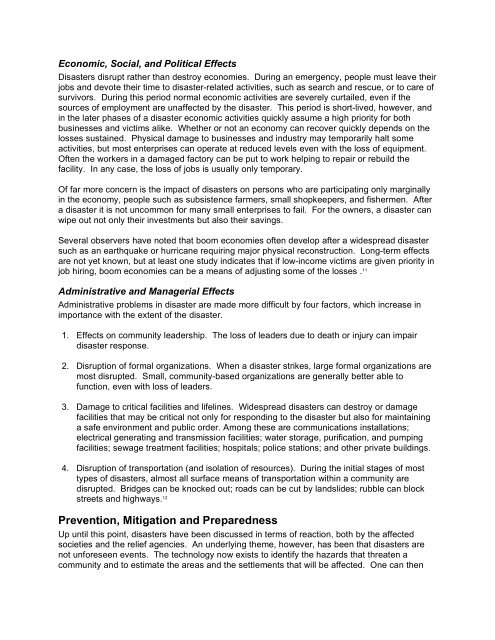Natural Hazards: Causes and Effects - Disaster Management Center ...
Natural Hazards: Causes and Effects - Disaster Management Center ...
Natural Hazards: Causes and Effects - Disaster Management Center ...
Create successful ePaper yourself
Turn your PDF publications into a flip-book with our unique Google optimized e-Paper software.
Economic, Social, <strong>and</strong> Political <strong>Effects</strong><br />
<strong>Disaster</strong>s disrupt rather than destroy economies. During an emergency, people must leave their<br />
jobs <strong>and</strong> devote their time to disaster-related activities, such as search <strong>and</strong> rescue, or to care of<br />
survivors. During this period normal economic activities are severely curtailed, even if the<br />
sources of employment are unaffected by the disaster. This period is short-lived, however, <strong>and</strong><br />
in the later phases of a disaster economic activities quickly assume a high priority for both<br />
businesses <strong>and</strong> victims alike. Whether or not an economy can recover quickly depends on the<br />
losses sustained. Physical damage to businesses <strong>and</strong> industry may temporarily halt some<br />
activities, but most enterprises can operate at reduced levels even with the loss of equipment.<br />
Often the workers in a damaged factory can be put to work helping to repair or rebuild the<br />
facility. In any case, the loss of jobs is usually only temporary.<br />
Of far more concern is the impact of disasters on persons who are participating only marginally<br />
in the economy, people such as subsistence farmers, small shopkeepers, <strong>and</strong> fishermen. After<br />
a disaster it is not uncommon for many small enterprises to fail. For the owners, a disaster can<br />
wipe out not only their investments but also their savings.<br />
Several observers have noted that boom economies often develop after a widespread disaster<br />
such as an earthquake or hurricane requiring major physical reconstruction. Long-term effects<br />
are not yet known, but at least one study indicates that if low-income victims are given priority in<br />
job hiring, boom economies can be a means of adjusting some of the losses . 11<br />
Administrative <strong>and</strong> Managerial <strong>Effects</strong><br />
Administrative problems in disaster are made more difficult by four factors, which increase in<br />
importance with the extent of the disaster.<br />
1. <strong>Effects</strong> on community leadership. The loss of leaders due to death or injury can impair<br />
disaster response.<br />
2. Disruption of formal organizations. When a disaster strikes, large formal organizations are<br />
most disrupted. Small, community-based organizations are generally better able to<br />
function, even with loss of leaders.<br />
3. Damage to critical facilities <strong>and</strong> lifelines. Widespread disasters can destroy or damage<br />
facilities that may be critical not only for responding to the disaster but also for maintaining<br />
a safe environment <strong>and</strong> public order. Among these are communications installations;<br />
electrical generating <strong>and</strong> transmission facilities; water storage, purification, <strong>and</strong> pumping<br />
facilities; sewage treatment facilities; hospitals; police stations; <strong>and</strong> other private buildings.<br />
4. Disruption of transportation (<strong>and</strong> isolation of resources). During the initial stages of most<br />
types of disasters, almost all surface means of transportation within a community are<br />
disrupted. Bridges can be knocked out; roads can be cut by l<strong>and</strong>slides; rubble can block<br />
streets <strong>and</strong> highways. 12<br />
Prevention, Mitigation <strong>and</strong> Preparedness<br />
Up until this point, disasters have been discussed in terms of reaction, both by the affected<br />
societies <strong>and</strong> the relief agencies. An underlying theme, however, has been that disasters are<br />
not unforeseen events. The technology now exists to identify the hazards that threaten a<br />
community <strong>and</strong> to estimate the areas <strong>and</strong> the settlements that will be affected. One can then








